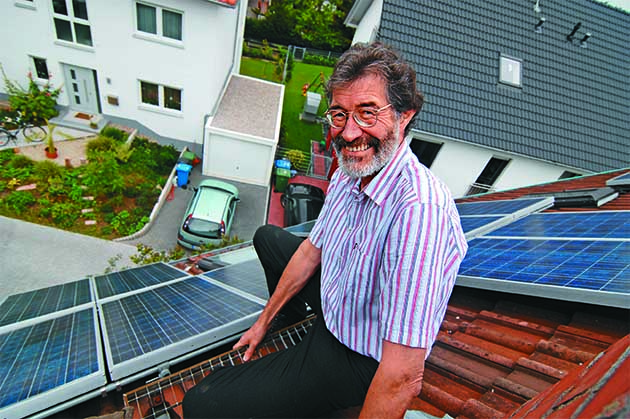Germany – European Renewable Energy Leader
Roofs that Make Money

Source:Ming-Tang Huang
Across Germany homeowners are installing photovoltaic systems on their roofs to generate electricity, and selling surplus power to utility companies. They are determined to help end the era of nuclear power through green energy.
Views
Roofs that Make Money
By Monique HouFrom CommonWealth Magazine (vol. 483 )
In the basement of Georg Rausch's single-family home, a device resembling a small water heater is mounted to the wall. The electronic display below it reads: "Total amount 11,759 Euros."
Rausch lives in Alsbach-Hähnlein, a municipality of less than 10,000 people, about 40 minutes by car from Germany's financial center of Frankfurt. The area is one of three in Germany offering the best natural conditions for solar power generation. Rausch was elected mayor of the town four years ago as candidate for IUHAS, a local environmental civic group under the umbrella of the Greens.
Eight years ago he was one of the first to install solar panels on his roof when the German government began to promote private solar power generation. Rausch sells the electricity that his roof generates to a local private power company.
The electricity meter in his basement measures all kinds of data – the total amount of electricity generated and money earned since the solar roof went online, as well as the kilowatts of power generated during the current day, the past week or the past year, and how much electricity can be generated based on the current amount of sunshine. All this information can be retrieved via the small display.
In Alsbach-Hähnlein the number of households with solar roofs has now grown from a handful to somewhere between 200 and 300. Most of these photovoltaic systems were installed after Rausch became mayor.
But instead of resting on his laurels, Rausch is making further efforts to convince the skeptics. He has commissioned a survey of all roofs in town that are not yet used for solar power generation. The aim is to analyze the roof orientation and calculate how many square meters of roof area could effectively be used for solar panels.
When the survey is completed, each homeowner will get a comprehensive report explaining how much money he or she will need to invest in a photovoltaic system, how much power it will be able to generate, when the loan will be paid off, and when the solar roof will actually begin to make money.
Banks Help Finance Solar Roofs
The roof of Rausch's home, for instance, has solar panels mounted only on one side. When Rausch went solar he obtained a low-interest loan of 0.9 percent from his bank. With the loan of 22,000 Euros, he had 28 square meters of solar cells installed.
The local electricity company buys the electricity that Rausch's solar system generates at 48 euro cents (about NT$20) per kilowatt-hour.
Rausch's roof can generate about 3,100 to 3,200 kilowatts per year, which can be sold for up to 1,600 euros (about NT$64,000), he notes with pride. According to his calculations, he will earn his investment back in 13 years, and from then on it will all be net earnings.
Thanks to Rausch's tireless efforts, the design of new homes being built in the town already considers key factors for solar photovoltaic systems such as roof orientation and angle.
A typical example is the new firehouse that is presently being built. The firehouse gate does not open toward the main street, but to the side, because that way, roof orientation can be optimized.
Rausch's neighbor has also just gotten his own solar roof and does not hide his stance. On the second floor of his home a banner appeals for the use of clean energy.
The German government has already decided to phase out nuclear power in 11 years. Rausch believes that, for the sake of future generations, Germans need to use solar and wind energy to build a non-nuclear homeland.
Clean Energy Generates NT$200 billion Per Year
Another bright spot at the horizon of new energy sources is Hamburg, a major port and industrial city.
Thanks to steady winds blowing from the North Sea and a flat topography that favors wind energy, Hamburg has become a European center for renewable energy. Multinationals like German engineering firm Siemens and U.S. conglomerate General Electric have chosen Hamburg for the headquarters of their wind energy business divisions.
In cooperation with local universities and research institutions such as Hamburg University of Applied Sciences, businesses, banks and trade associations, the Hamburg city council has established the Hamburg Renewable Energy Cluster, an industry association that markets the city as an international logistics and administrative hub for renewable energy businesses.
The banking industry plays a crucial role in the city's strategy to market itself as a renewable energy cluster.
Germany's second largest bank Commerzbank has pooled its renewable energy know-how in Hamburg with the establishment of its Center of Competence Renewable Energies, which helps investors from across Germany, and indeed the world, to invest in Hamburg's renewable energy industry.
Three other major lenders – Dresdner Bank, HSH Nordbank, and HypoVereinsbank – also provide financing and consulting services in the renewable energy sector.
Currently, Hamburg is home to more than 600 companies that are active in this sector, providing more than 10,000 jobs and generating more than 5 billion euros in revenue per year. And the trend is only growing, as more and more jump on the renewable energy bandwagon.
Translated from the Chinese by Susanne Ganz






